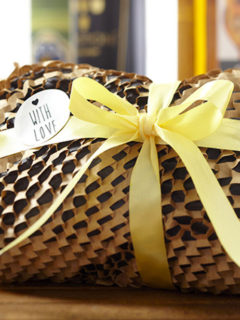Safety glasses can protect your eyes from UV rays, flying particles and even chemicals. Safety glasses come in different shapes, with a variety of lens types and lenses. Choosing stress? No need for it! We collected the 7 most frequently asked questions on safety glasses for you. That way, you’re sure to make the right choice at the end of the day.
1. Why should I wear safety glasses?
Safety glasses protect your eyes from three types of risk:
- Mechanical risks: dust, knocks, stabs or foreign objects such as splinters.
- Chemical risks: solid or gaseous substances, splashes, drops and mist.
- Radiation risks: UV rays, welding light, laser rays, infrared radiation and heat radiation.
2. What type of safety goggles do I need?
]Depending on the work you do, you have a choice of three types of goggles: the standard splash goggle, the goggle overlay and the wide-view goggle. Such goggles are also called ‘goggles’ and give you the highest protection.
Standard splash goggles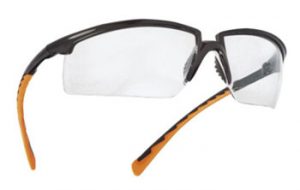 |
Supplementary glasses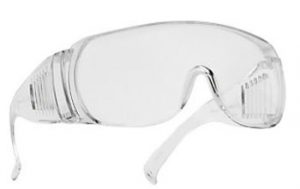 |
Goggles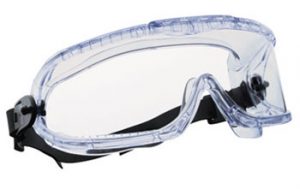 |
| Light work | Light work | Medium or heavy duty |
| Protects against mechanical or radiation hazards (not harmful to the skin) | Protects against mechanical or radiation hazards (not harmful to the skin) | Protects against chemicals, acid gases, solvents and other hazardous substances |
| Does not cover the face. Cover your eyes even better with glasses with side protection | Worn over corrective spectacles | Fits completely to the face With elastic band around the head |
3. What material are safety goggles made of?
The most important part of your glasses is undoubtedly the lens. Such a lens is usually made of polycarbonate (40x stronger than glass), acetate or glass. Each of these materials has its own advantages and disadvantages.
| Polycarbonate | Acetate | Glass | |
| Weight | Light | Light | Heavy |
| Scratch-resistant | Poor | Medium | Good |
| Chemical resistant | Average | Good | Very good |
| Impact resistant | Very good | Good | Average |
| Heat resistant | Good | Average | Very good |
4. Which regulations should safety glasses comply with?
Euronorm EN 166 lays down all the basic requirements that safety glasses must meet by law. According to that standard, such glasses must be optically neutral, for example: they must not cause fatigue or headaches. More importantly, the glasses must provide good resistance to general hazards, mechanical risks and shocks or impacts. In addition, by the way, there are a number of additional safety standards, including these:
- EN 169: filters for welding and associated techniques.
- EN 170: UV filters.
- EN 171: infrared filters.
- EN172: sunlight filters for industrial use.
Both the lens and the eyeglass spring are labelled. These figures and numbers give you a lot of information about the precise use of the glasses. You will find a detailed overview below. In blue we have indicated the lens spring, in red the lenses.
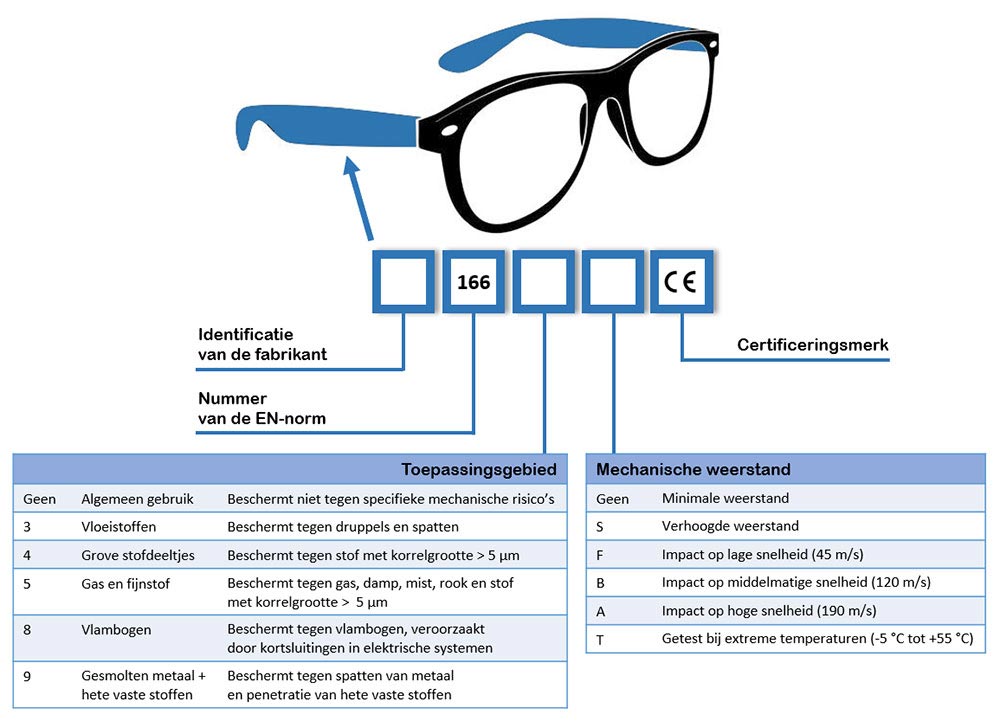
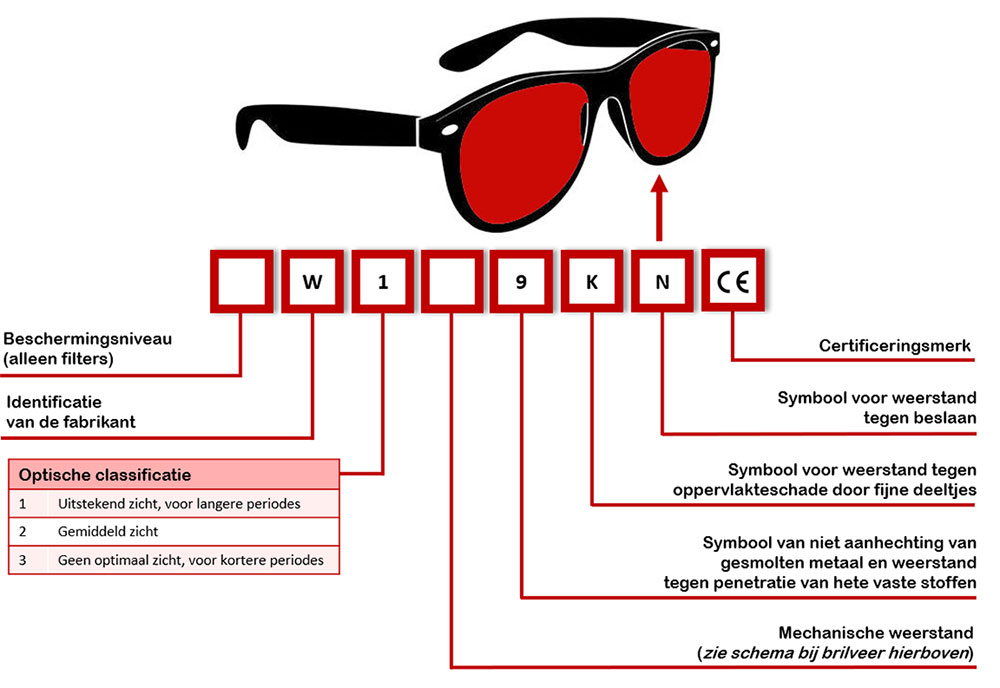
5. Which coating should my lens have?
The lenses of your glasses are usually coated with a special layer, a coating. Depending on the work you do, this can be useful – or even indispensable.
- Anti-fog: these lenses will not fog up, regardless of the working or weather conditions. Convenient and safe. Check out our Pacaya or V-Maxx glasses with anti-fog coating here.
- Anti-scratch: these lenses are more resistant to scratches. Ideal for those who often leave their glasses lying around in ‘sensitive places’ (e.g. in a toolbox).
- Anti-UV: too much UV light can increase the risk of retinal diseases. Therefore, choose a lens with a good UV filter. All glasses from RAJA already meet this requirement.

6. What colour should my lens be?
You can buy safety glasses with different lens colours. Anyone who thought this is just for a fancy look is wrong… After all, again, everything depends on the work you do.
- Clear lenses: are suitable for general work and provide a natural colour image.
- Yellow or orange lenses: offer you increased contrast and even better protection against UV light and blue light.
- Smoke-coloured glasses: offer better protection from sunlight and bright glare. This gives you less irritation and less eye strain. Ideal for those who work outside in direct sunlight, for example.
7. Which safety glasses should you wear in corona?
Like most viruses, COVID-19 virus thrives best in moist and warm environments. Our eyes are one such high-risk area. Wearing safety glasses is therefore highly recommended in a number of situations. Remember to always wash your hands thoroughly before putting on glasses.
- When social contact is less than 1.5 metres: for hairdressers, beauticians, cashiers, etc. In these professions, the rule of keeping a distance of 1.5 metres often cannot be observed. A face shield (or face shield) is then a welcome solution. It encloses your entire face without obstructing your view.
- For direct physical contact: for nurses, among others. Wear glasses that completely cover the eyes. Best to opt for wide-view glasses or goggles.
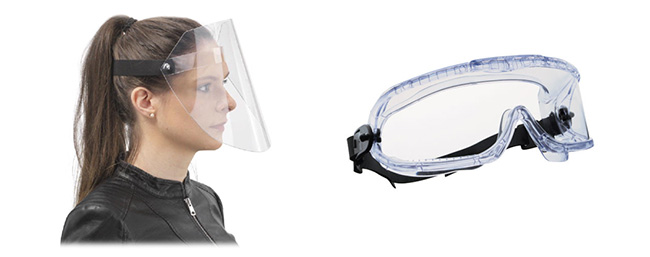
Ready to make your choice? Meet RAJA’s best-selling splash glasses here:
Delta Plus Pacaya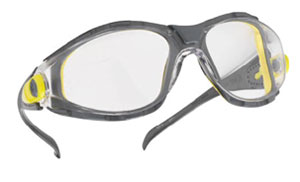 |
Honeywell A800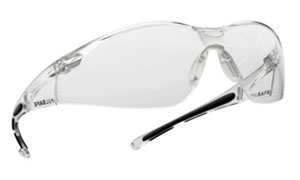 |
Honeywell Op-tema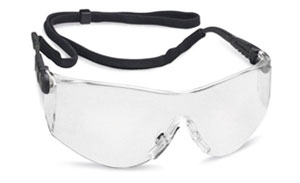 |
| With foam protectors to better absorb shocks. | The most economical. With extra-long protection along the sides. |
With 1-piece lens for wider vision. With strap to never lose it. |
| Anti-scratch / anti-uv Anti-fog |
Anti-scratch / Anti-uv | Anti-scratch / Anti-uv |











